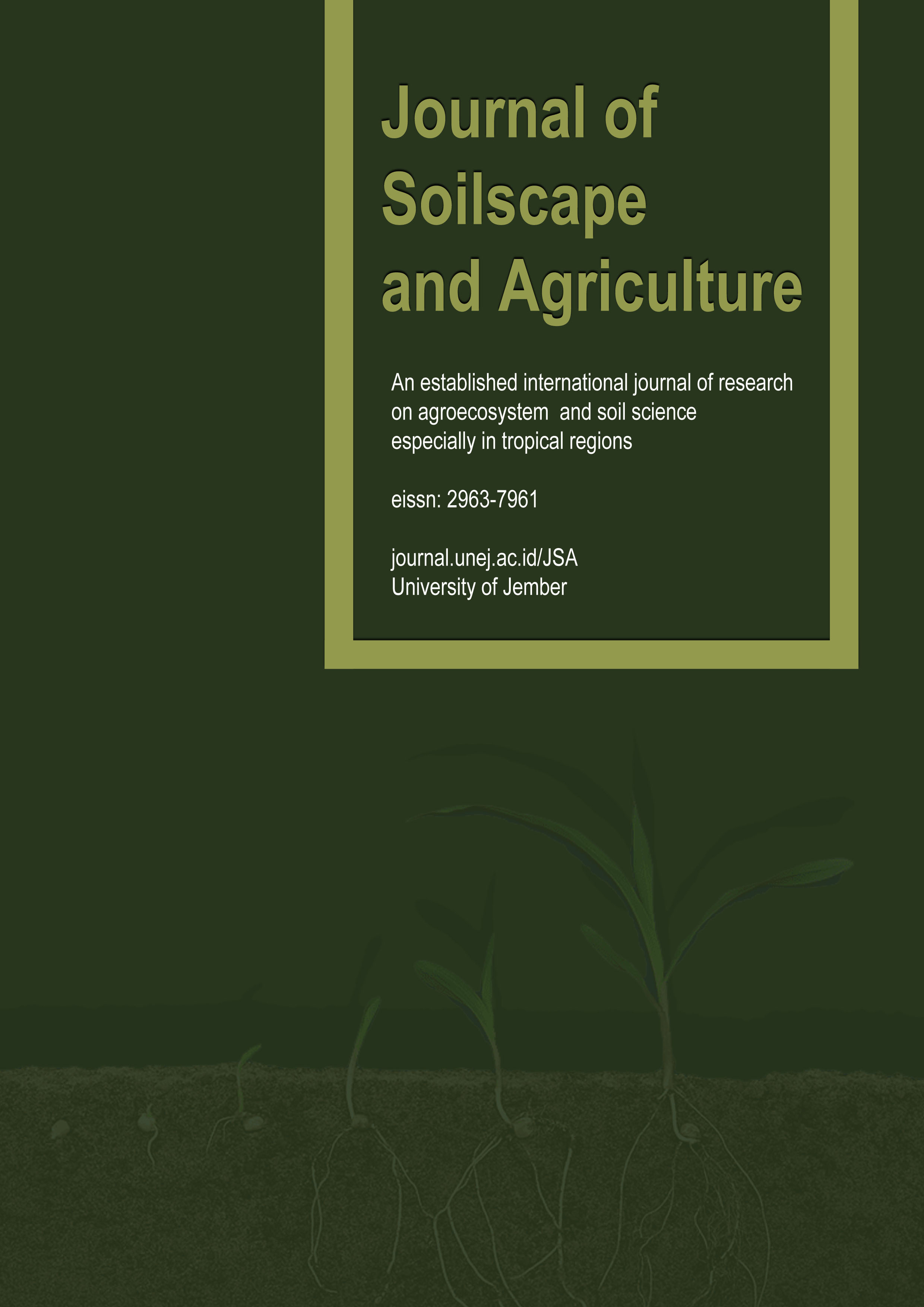Estimation of Carbon Stock as an Impact of Land Use Change in Anduonohu Village, Poasia District, Kendari City
DOI:
https://doi.org/10.19184/jsa.v4i1.6393Keywords:
Anduonohu Village, Carbon Reserves, Land UseAbstract
The rapid development of Kendari City has led to numerous changes in land use for commercial activities, thereby unknowingly reducing stored carbon reserves. The change in forest function, which is dominated by land for human settlement and trade activities, has reduced the amount of stored carbon reserves. Anduonohu Village is the largest village in the Poasia District, covering an area of 14.11 km²(32.88% of the total area of the Poasia District). The rapid development of Kendari City has led to numerous land changes for commercial activities, thereby reducing stored carbon reserves. The objectives of this study are 1) to determine land use in Anduonohu Village, Poasia District, Kendari City, and 2) to determine carbon reserves as a result of land use changes in Anduonohu Village, Poasia District, Kendari City. This research was conducted in Anduonohu Village in June-July 2023. The research method used was a quantitative descriptive method with data collection techniques, namely observation, documentation, and literature study techniques, and using spatial analysis to analyze the quantitative data obtained. The results obtained in this study are 1) land use in Anduonohu Village in 2018 and 2022 is divided into seven types, namely secondary dryland forest, plantations, secondary mangrove forest, settlements, shrubs/scrub, additional land, and open land. Of the seven types of land use in Anduonohu Village, the largest land change between 2018 and 2022 was in the residential area, which increased by 487 ha. 2) The amount of carbon reserves in Anduonohu Village in 2018 was 868.354 tons/ha and decreased to 822.181 tons/ha in 2022 from the seven types of land use in Anduonohu Village.ha in 2022 from the seven types of land use in Anduonohu Village.
References
Ahlström, A., Schurgers, G., & Smith, B. (2012). Robustness and uncertainty in terrestrial ecosystem carbon response to CMIP5 climate change projections. Environmental Research Letters, 7(1), 044008.
Aklile, Y., & Fekadu, B. (2014). Examining drivers of land use change among pastoralists in eastern Ethiopia. Journal of Land Science, 4(9), 402–413.
Arifanti, V. B., Dharmawan, I. W. S., & Wicaksono, D. (2014). Carbon stock potency of sub-montane forest stand in Mount Halimun Salak National Park. Forestry Socio and Economic Research Journal, 11(493), 13–31.
Asma, N. (2018). Analysis of aquaculture land use change using the maximum likelihood method (Case study: Banda Aceh City) [Undergraduate thesis, Syiah Kuala University Darussalam].
Fatoni, A. (2011). Research methodology and thesis writing techniques. Jakarta: PT Rineka Cipta.
Hualong, L., Yongqiang, L., Xuegang, H., Tingting, L., & Yuri, L. (2014). Effects of land use transitions due to rapid urbanization on ecosystem services: Implications for urban planning in the newly developing area of China. Habitat International, 44, 536–544.
Karuru, S. S. (2021). Estimation of carbon reserves in various land covers in East Luwu Regency [Master’s thesis, Hasanuddin University Graduate School].
Rianse, U., Taufiq, E. S., & Rembon, F. S. (2015). Analysis of housing growth in Puuwatu District, Kendari City [Undergraduate thesis, Halu Oleo University].
Sugiyono. (2019). Quantitative, qualitative, and R&D research methods. Bandung: Alfabeta.
Sumarlin, D., Gusmayanti, E., & Anshari, G. Z. (2021). Analysis of land use change and carbon stocks as indicators of environmental degradation in Sandai District, Ketapang Regency. Journal of Environmental Science, 19(3), 576–581.
Tosiani, A. (2015). Carbon absorption and emission activity book. Ministry of Environment and Forestry, Directorate General of Forestry Planning and Environmental Management, Directorate of Forest Resource Inventory and Monitoring.
Yu, T., Feng, L., Ruong, W., & Dan, Z. (2014). Effect of land use and cover change on terrestrial carbon stocks in urbanized areas: A study from Changzhou, China. Journal of Cleaner Production, 1–7.
Yuzhe, W., Xiaoling, Z., & Liyin, S. (2011). The impact of urbanization policy on land use change: A scenario analysis. Cities, 28, 147–150.
Downloads
Published
How to Cite
Issue
Section
License
Copyright (c) 2025 Journal of Soilscape and Agriculture

This work is licensed under a Creative Commons Attribution-NonCommercial-ShareAlike 4.0 International License.



